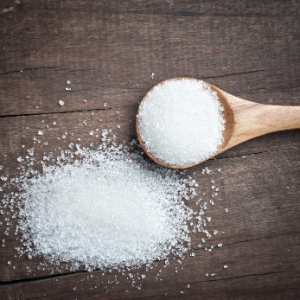When it comes to sugar, how much is too much?

Who doesn’t love a chocolate chip cookie straight out of the oven? Or an icy cold soft drink on a hot summer day? These are tempting for sure, but do you know how much sugar you or your kids are eating when you indulge in one of these sweet treats?
Data from the Canadian Sugar Institute shows that Canadians consume an average of 10 to 13 % of their total energy from added sugars. Health Canada recommendations state that a maximum of 25 % of our daily energy come from sugar (i.e. all sugars), but a recent StatsCan survey shows that Canadian children and teens are consuming more than that amount. What’s more, they’re eating less fruit, vegetables and milk products than are recommended
What’s in a name?
Many people are confused by the term “sugars” on food labels. Sugars are just simple carbohydrates and they come in different forms. They can occur naturally in foods or may be added to foods. Added sugars can be anything from sucrose (table sugar), honey, and agave syrup to dextrose and high-fructose corn syrup. When your child eats foods such as chocolate bars or drinks a soda, they’re consuming foods that are high in added sugars and energy with little or no nutritional value. Although these sugars are not “bad”, eating too much of them replaces more nutritious foods, plus there’s the added concern of contributing to dental cavities.
Foods that contain naturally occurring sugars such as fruit and dairy products are more nutritious. In addition to sugars, they contain other nutrients like fibre and protein, which make our bodies work a little bit harder to digest them. These foods also provide essential nutrients for our bodies such as vitamins and minerals, which are not found in added sugars.
It’s all there in black and white
Many of the processed foods available today have large amounts of added sugar. This includes snack foods, crackers, cookies, soft drinks—even soups and salad dressings. But you can do some detective work before you buy: just turn the package over and read the label.
Unfortunately you won’t find the detailed info you need on the “nutrition facts” panel where “sugars” are listed as the total of naturally occurring sugars and added sugars. However, the federal government has proposed changes to the guidelines for packaged foods that will require food producers to list added sugars separately. In the meantime, reading the ingredient list will give you a good idea of what’s inside the package. Foods with sugar or added sugar (see examples below) listed in the first few ingredients should be eaten less frequently.
And if you’re thinking that it’s better to buy products with added “natural” sugars, think again. Honey and unrefined sugars are no higher in nutrients than plain old white sugar, so choosing foods with these ingredients provides no advantage.
What about foods that are labeled “No added sugar”?
Maybe you’ve seen cookies, chocolate bars, candies and even ice cream that are labeled “No added sugar”. These foods use alternative sweeteners known as “sugar alcohols” that can cause cramps, gas and diarrhea, especially in children, so they’re not usually a better choice.
Back to basics
One good way to limit the amount of added sugar your kids consume is to steer your shopping cart to the outer aisles of the supermarket, where you’re more likely to find fresh fruit and vegetables, whole grain breads and dairy products (with no added sugar of course!)
Make a sweet deal with your family
Take a “sugar inventory” of your family’s diet and if you need to cut back, take a step-by-step approach. Don’t make drastic changes all at once, but rather introduce new foods, or more of the good foods, while you phase out the sugar culprits. For example:
- In the morning, instead of white or brown sugar on your cereal or oatmeal, try berries or other fruit (fresh or frozen)
- Add berries to plain yogurt
- Prepare fresh vegetables such as carrots or snow peas for a snack
- Dole out a handful of almonds or walnuts as a snack
- Instead of orange juice, have an orange. The taste is the same (even better!) and it provides fibre too.
- Encourage your children to drink water to quench their thirst and limit high-sugar soft drinks.
Cutting out sweets altogether doesn’t have to be the end goal, but following the recommended number of serving in Canada’s Food Guide will help make everyone in the family less dependent on sweets, and make those special desserts and the occasional soft drink seem like the treats they were meant to be!
When grocery shopping, check products to see if any of these added sugars are listed in the first few ingredients:
- Agave nectar
- Brown sugar
- Cane crystals
- Cane sugar
- Corn sweetener
- Corn syrup
- Crystalline fructose
- Dextrose
- Evaporated cane juice
- Fructose
- Fruit juice concentrates
- Glucose
- High-fructose corn syrup
- Honey
- Invert sugar
- Lactose
- Maltose
- Malt syrup
- Molasses
- Raw sugar
- Sucrose
- Sugar
- Syrup
Sources:
- http://www.heart.org/HEARTORG/GettingHealthy/NutritionCenter/HealthyDietGoals/Sugars-and-Carbohydrates_UCM_303296_Article.jsp
- http://www.heartandstroke.bc.ca/site/c.kpIPKXOyFmG/b.4408531/k.B33/Health_Check_nutrient_standards_for_sugar.htm
- http://www.cdc.gov/nchs/data/databriefs/db87.htm
- http://www.hsph.harvard.edu/nutritionsource/added-sugar-on-food-labels/
- http://www.statcan.gc.ca/pub/82-003-x/2011003/article/11540/tbl/tbl1-eng.htm


